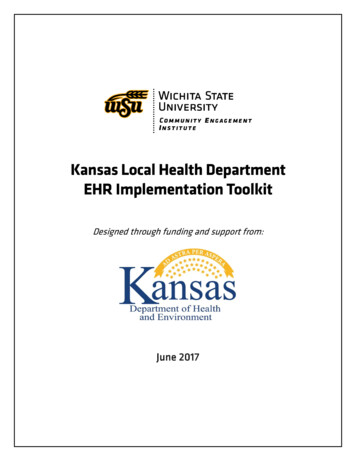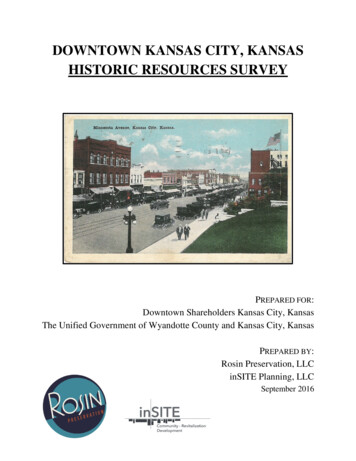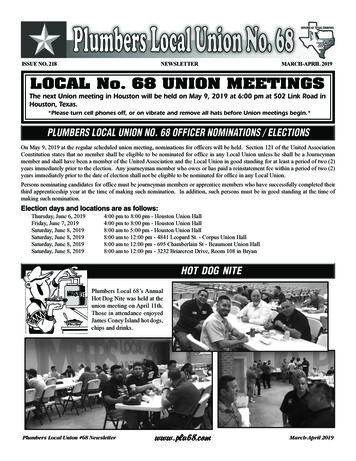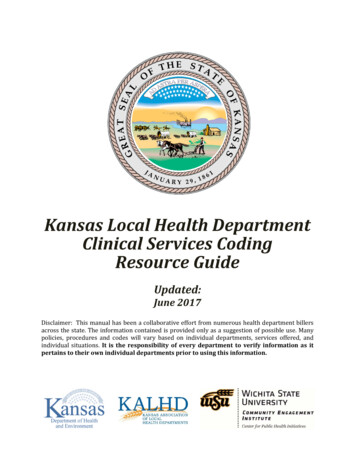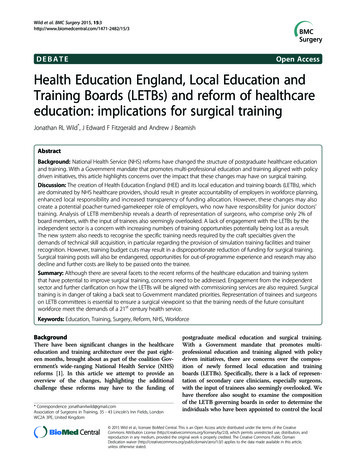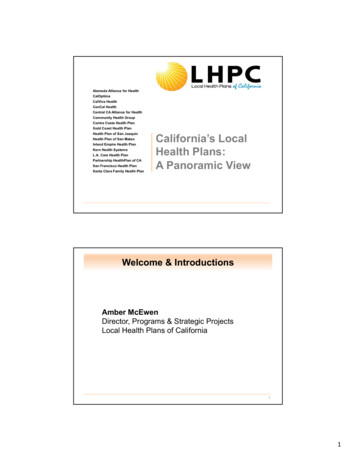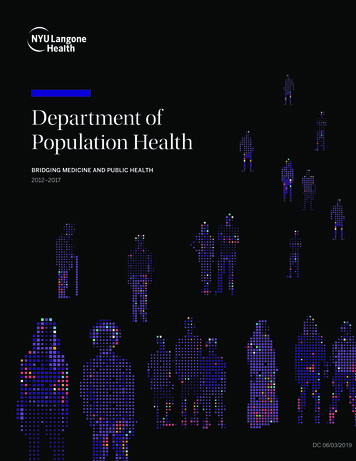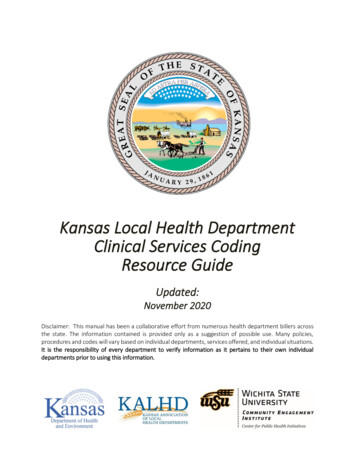
Transcription
Kansas Local Health DepartmentClinical Services CodingResource GuideUpdated:November 2020Disclaimer: This manual has been a collaborative effort from numerous health department billers acrossthe state. The information contained is provided only as a suggestion of possible use. Many policies,procedures and codes will vary based on individual departments, services offered, and individual situations.It is the responsibility of every department to verify information as it pertains to their own individualdepartments prior to using this information.
Kansas Local Health Department Clinical Services Coding Resource GuideNovember 2020PREFACEThe Public Health Billing Resource Guide provides policy & procedural guidance on how to bill 3rdparty payers for public health programs and services. Developed as a billing resource tool; itspurpose is to assist state, district and county public health staff in understanding the insurancecoding and billing process.Part I-The Policies and Procedures section focuses on the terms and conditions of billing andreimbursement from 3rd party payers. It provides guidance on eligibility & verification,coordination of benefits and billing procedures to avoid delays in reimbursement.Part II-The Billing & Coding: Methodologies & Rates section emphasizes the importance of theclinical components of CPT coding to ensure 3rd party payers are charged at the appropriatelevel of service delivery and reimbursement.The Appendices section includes Related Links, Billing Contact Information, Acronyms,Definitions, and other resources used in mastering the reimbursement process.Amendments are made Semi-annually in accordance with policy changes in federal and state laws.Disclaimer: Contract Provisions between LHD and 3rd Party Private Payers contain confidential andproprietary information that prohibits dissemination, distribution or disclosure of reimbursementrates to any parties other than county Boards of Health and LHD employees.Currently, KanCare is contracted with the following 3rd Party Payers for Immunization Services:Sunflower State Health PlanAetna Health PlanUnited Healthcare Community PlanNote: MediKan and Medicare are accepted for other services, i.e., Maternal and Child Health, FamilyPlanning, Adult Health, etc. in most of our county health departments.Special thanks to all of the billers who worked on this manual and those who will contribute to futureupdates. This work would not have happened without you.Any comments or suggestions for updates and changes to this manual can be emailed to the billerslisted in section 11.6 or aaron.davis@wichita.edu.PREFACE2 Page
Kansas Local Health Department Clinical Services Coding Resource GuideNovember 2020Updates from January 2020 VersionSectionCover1.2 Medicaid EnrollmentProcess2.2 Insurance Eligibility &Verification4.5 Medicaid Denial IssuesUpdate NotesDate/version updatedAdditional information added (Submitting your application)5.1 Website IntroductionUpdated to most current version of the Professional Billing Packet5.7 How to look up MaximumReimbursement Rates for PublicHealth Providers6.1 MethodologiesStep by step instructions updated6.7 Influenza VaccineProducts8.1 Women’s HealthUpdates to products and codes for 2020-2021 seasonServices: Methodologies10.2 CLIA CertificationSection 11 AppendicesUpdates from January 2020 VersionAdditional information added (Beneficiary Responsibility)Updated MCO contact informationUpdates to guidance on software charge requirementsUpdates to guidance on coverage of E&M servicesGuidance for CLIA certification and processingNew appendices have been added and updated 11.2 Updates to TPL exemptions, J codes, and CLIAwaived tests 11.3 Related Links – broken links have been updated and newlinks have been added (UHC, Palmetto GBA eServices, etc)3 Page
Kansas Local Health Department Clinical Services Coding Resource GuideNovember 2020TABLE OF CONTENTSPART IBILLING POLICIES & PROCEDURESSection 1Section 2Section 3Provider Enrollment1.11.21.3Insurance Eligibility & Verification2.12.2Section 5IntroductionEligibility & VerificationCoordination of Benefits3.13.23.33.4Section 4IntroductionMedicaid Enrollment ProcessPrivate Insurance Enrollment ProcessIntroductionPrimary & Secondary PayersThird Party Liability PaymentsThird Party Liability Non-Covered List (Blanket Denial)Claim Submission & Resubmission4.14.24.34.44.54.6IntroductionClaim RequirementsFiling Time LimitsAppeals ProcessMedicaid Denial IssuesMCO Reconsideration ProcessKansas Medical Assistance Program (KMAP)5.1 Website Introduction5.2 Eligibility Verification and Prior Authorizations5.3 KanCare Claim Submission & Inquiry5.4 Manuals, Forms and Bulletins5.5 Interactive Tools - KMAP Reference Codes5.6 KMAP Fee-for Service Provide Manual: Record Retention5.7 How to look up Medicaid reimbursement rates for public healthprovidersTABLE OF CONTENTS4 Page
Kansas Local Health Department Clinical Services Coding Resource GuidePART IINovember 2020METHODOLOGIES & COMMON LHD CODINGSection 6Immunization Services6.16.26.36.46.56.66.76.8Section 7Section 8Section 9MethodologiesVaccine GuidanceImmunizations 18 years of age and youngerImmunizations 19 years of age and olderMedicare Part BMedicare Part DInfluenza Vaccine Products 2016-2017 SeasonInternational TravelChild Health Services7.17.27.37.4MethodologiesChild Health VisitsChildren’s Intervention Services (CIS)Maternal & InfantWomen’s Health Services8.18.2MethodologiesFamily Planning (FP)Adult Health / Miscellaneous Services9.1. Methodologies9.2 Adult Health9.3 Miscellaneous ServicesSection 10Laboratory Services10.1Section .1011.1111.12TABLE OF CONTENTSLaboratory Service CodesComponent Requirements for Office & Home VisitsVaccine route Administration CodesRelated LinksAcronymsDefinitionsKALHD Billing List-Serve & Regional Billing GroupsState LHD MapVaccine Guidance (Private, VFC, and CHIP)*Common Payer ID’sClaim SamplesNDC Conversion TableKan-Be-Healthy Billing Reference5 Page
Kansas Local Health Department Clinical Services Coding Resource GuideNovember 2020PART IBILLING POLICIES& PROCEDURESTT6 Page
Kansas Local Health Department Clinical Services Coding Resource GuideNovember 2020Section 1Provider Enrollment1.1 IntroductionProviders must be enrolled as a qualified provider with a 3rd party payer before they can submitclaims for reimbursement. This section provides guidance on the Enrollment Process.1.2 Medicaid Enrollment ProcessA Kansas Medical Assistance Program (KMAP) Provider Agreement must be completed in order toparticipate in the Kansas Medical Assistance Program The State has selected three health plans, or managed care organizations (MCOs), to provide servicesto Medicaid consumers in the KanCare program. More information about each plan and how tocontact them can be found at formation.Departments must enter into contracts with each MCO individually. KMAP enrollment is requiredbefore enrolling with a Medicaid MCO. Submitting an application or revalidating your existingapplication online, through the KMAP portal, will allow you to submit one application and selectFee for Service, Aetna, Sunflower and United Healthcare. Once your application or revalidationhas been approved your application will be sent via the Portal to the MCO(s) you selected, forthat MCO to start their credentialing process.1.3 Private Insurance Enrollment ProcessIn order to bill most payers, the LHD must be contracted with the payer. It is best to contact eachpayer and ask how claims will be processed with and without a contract. Also an LHD may contractwith a network. This allows the LHD to bill multiple payers under one contract. These are links in thePDF version of this manual.PayerPrivate InsurancesBCBSAetnaBCBSAetnaCoventry Health Care KSPreferred HealthNetwork of insurancesProviDr’s Care (WPPA)WPS – Medicare BRailroad MedicareHPKProviDr’sWPSPalmettoGBAProvider EnrollmentPhone oviders.nsf/DocsCatHome/Railroad%20Medicare7 Page
Kansas Local Health Department Clinical Services Coding Resource GuideNovember 2020Section 2Insurance Eligibility & Verification2.1IntroductionThe business of Public Health begins with clients seeking services at local county health departments.This Section provides guidance on client intake and the steps required to obtain insurance informationfor billable services rendered in public health.2.2Eligibility & VerificationFrontline staff should brief clients on the intake process prior to receiving services. An effective intakeprocess begins with a registration form that gathers vital information on the client’s demographics,insurance coverage, and services requested. New Patients should complete a form at their first visit.Departments should set a policy to have Established Patients complete one at every visit or if theyhave any changes in their information since their last visit. Verifying and updating this information iscritical at every visit.Important Steps that should be taken with every client at every visit: Copy the client’s primary and any secondary insurance cards Verify eligibility, policy status, effective date, type of plan and Exclusions Inform client of their responsibility for co-pays, coinsurances and deductibles Inform client of Waiver for non-covered services and payment optionsIt is to the benefit of the Provider to verify coverage before services are rendered. Failure to do so mayresult in non-payment of non-covered services and difficulties recouping payment from the client afterservices have been provided. “Active” coverage does not guarantee reimbursement for services listedon the Fee Schedule. Please refer to the client’s individual Insurance Plan/Exclusions to identify“Non-Covered” services. Additional information regarding specific eligible members or programrequirements can be found at sheets.In order to charge clients for non-covered services, a Waiver for Non-Covered Services with thefollowing information must be provided to the client: Identify the service that is not covered Identify covered service that may be available in lieu of the non-covered service The cost of the service and payment arrangements The client must sign the Waiver indicating acceptance of the non-covered service andagreement to pay for the non-covered serviceThe beneficiary booklet and enrollment packet information for 2020 Member Open Enrollment isavailable at an. Medicaid/KanCare eligibility canbe verified at https://www.kmap-state-ks.us. This is a secure portal that requires a KMAP usernameand password.Insurance Eligibility & Verification8 Page
Kansas Local Health Department Clinical Services Coding Resource GuideNovember 2020Beneficiary Responsibility: The KMAP beneficiary can be held responsible for the payment of commonservices and situations. Beneficiaries may be billed only when program requirements have been metand the provider has informed the beneficiary in advance and in writing.Suggested content for the Advance Beneficiary Notice (ABN): This constitutes advance notice to you,the beneficiary, that if all program requirements are met by (the provider) and payment is not made byMedicaid, you may be held responsible for the charges if your services are not covered by Medicaid.For services where there is normally no face-to-face contact between the beneficiary and the provider(examples are lab and radiology services), the written ABN signed annually by the beneficiary with thereferring provider is an appropriate notification of responsibility for payment of noncovered charges.More information can be learned at ider%20Manuals/General%20TPL 12282010 10155.pdfProvider Discretion: It is a Provider’s discretion to accept a Medicaid/KanCare member as a client.By accepting a Medicaid/KanCare member as a client, the Provider1Agrees to accept, as payment in full, the amount paid by Medicaid/KanCare for all coveredservices with the exception of co-pays and payments from 3rd party payers.2Is prohibited from choosing specific procedures for which the Provider will acceptMedicaid/KanCare, whereby the Medicaid client would be required to pay for one type ofcovered service and Medicaid to pay for another service if applicable.Failure to comply with these procedures will subject the Provider to sanctions, up to andincluding termination from the Medicaid/KanCare Program.Some Departments will use procedures such as:When a client is ready to check-out, the pay station collects any copayments, deductibles, andservice fees. Payment in full is expected at time of service. If a client is unable to pay, the clinicalmanager may make payment arrangements. The clinic manager should reinforce the Board of Health’sor Health Department’s billing policy and resolve the issue with the client through an agreed paymentplan.Insurance Eligibility & Verification9 Page
Kansas Local Health Department Clinical Services Coding Resource GuideNovember 2020Section 3Coordination of Benefits3.1IntroductionBy federal law, Medicaid is the “payer of last resort” in most circumstances. Coordination of Benefits(COB) is the process of determining the primary payer. This section will help define the “payer of lastresort” status when submitting claims for payment. To find out more information on COB please referto General TPL Payment Manual on the KMAP website.3.2Primary & Secondary PayersThird-party liability (TPL) is often referred to as other insurance (OI), other health insurance (OHI), orother insurance coverage (OIC). Other insurance is considered a third-party resource for thebeneficiary. Third-party resources can be health insurance (including Medicare), casualty coverageresulting from an accidental injury, or payments received directly from an individual who has eithervoluntarily accepted or been assigned legal responsibility for the health care of one or morebeneficiaries.The Kansas Medical Assistance Program (KMAP) is a secondary payer to all other insurance programs(including Medicare) and should be billed only after payment or denial has been received from suchcarriers. The only exceptions to this policy are listed below: Children and Youth with Special Health Care Needs (CYSHCN) program Kansas Department for Children and Families (DCF), formerly SRS Indian Health Services (IHS) Crime Victim's Compensation Vaccine for Children Program3.3Third Party Liability PaymentDetails for TPL billing can be found at ider%20Manuals/General%20TPL 05092019 19082.pdf underGeneral TPL Payment Manual. The Provider's Role Billing Requirements Other Insurance Pricing Billing TPL after Receipt of KMAP Payment TPL Payment after Medicaid Payment No Response from Other Insurance Documentation Requirements Blanket Denials and Noncovered CodesCoordination of Benefits10 P a g e
Kansas Local Health Department Clinical Services Coding Resource GuideNovember 2020The following tips will assist Providers in reducing payment delays attributed to COB- related problems:1. Ask All Patients about Secondary Insurance Coverage. Collect and confirm primary and secondaryinsurance information at each visit.2. Know What Plans and Payers Need to Pay Claims. Nearly all plans require a copy of the Explanationof Benefits (EOB) from the primary payer prior to paying a claim as the secondary payer. Most plansand payers publish their requirements and the information should be available in provider manuals,online, and by contacting physician/provider representatives.3. Primary & Secondary Payers: The following rules are used to determine the primary and secondarypayer: a) The payer covering the patient as a subscriber will be the primary payer. b) If the patient is adependent child, the payer whose subscriber has the earlier birthday in the calendar year will be theprimary payer. This is known as the Birthday Rule.WHAT IF the Medicaid Member is also eligible for Medicare?SERVICE BY MEDICAID PROGRAMHealth Check/ImmunizationFamily PlanningPerinatal Case Management/PregnancyRelated ServicesDental Services (Health Check, Adult)Adult Services/ImmunizationsNurse Practitioner/Physician ServicesMEDICAREDoes not CoverDoes not CoverMEDICAIDPrimary PayerPrimary PayerDoes not CoverPrimary PayerDoes not CoverPrimary Payer-Flu, Pneumonia, Hep B;MNT; Preventive ServicesPrimary PayerPrimary PayerSecondary PayerSecondary PayerWHAT IF the Medicaid Member is also eligible for other private insurance coverage?SERVICE BY MEDICAID PROGRAMHealth Check/ImmunizationsPerinatal Case Management/Pregnancy RelatedServicesFamilyPlanningAdult Services/ImmunizationsNurse Practitioner/Physician ServicesDental Services (Health Check, Adult)Coordination of BenefitsPRIVATE INSURANCEMEDICAIDN/APrimary PayerN/APrimary PayerCOB REQUIREDCOB REQUIREDCOB REQUIREDCOB REQUIRED11 P a g e
Kansas Local Health Department Clinical Services Coding Resource GuideNovember 20203.4 Third Party Liability Noncovered List (Blanket Denial)When a service is not covered by a beneficiary’s primary insurance plan, a blanket denial letter can berequested from the insurance carrier. The insurance carrier should then issue, on company letterhead, adocument stating the service is not covered by the insurance plan covering the Medicaid beneficiary. Theprovider can also use a benefits booklet from the other insurance if it shows that the service is not covered.Providers can retain this statement on file to be used as proof of denial for one year. The noncovered statusmust be reconfirmed and a new letter obtained at the end of one year.The most up-to-date TPL Noncovered List is located on KMAP and can be accessed here: d.aspCoordination of Benefits12 P a g e
Kansas Local Health Department Clinical Services Coding Resource GuideNovember 2020Section 4Claim Submission / Resubmission4.1 IntroductionThe Submission & Resubmission of Claims focuses on the importance of converting clinical servicesprovided to a client into billable claims and submitting them via an Electronic Data Interchange to 3rdparty payers for reimbursement. To receive proper payment for services, public health billing staffmust collect accurate information required to submit a CMS 1500 insurance form correctly.4.2 Claim RequirementsProviders must take all reasonable measures to determine a 3rd Party Payer’s liability for coveredservices prior to filing a Medicaid claim. If a 3rd party insurance plan denies or pays insufficiently theapplicable reimbursement rate: Attach proof of other insurance denial (an RA or letter of EOB from the insurer). Denialsrequesting additional information from the primary insurance company will not be accepted asproof of denial from the other insurance. If dates of service are over 12 months old, originaltimely filing must be proven as defined in Section 5100 of the General Billing Fee-for-ServiceProvider Manual. An original denial is only acceptable for the same service date(s) on the claim. When a Medicare supplemental plan (for example Plan 65) is the only other insuranceapplicable to the beneficiary and Medicare has denied payment on the claim, the provider isnot required to submit the claim to the Medicare supplemental for denial. In this instance, theprovider should resolve all denials through Medicare prior to billing the Medicare supplementalplan and Medicaid. When a carrier issues a blanket denial letter f
Provider Enrollment 1.1 Introduction Providers must be enrolled as a qualified provider with a 3rd party payer before they can submit claims for reimbursement. This section provides guidance on the Enrollment Process. 1.2 Medicaid Enrollment Process A Kansas Medical Assistance Progra
